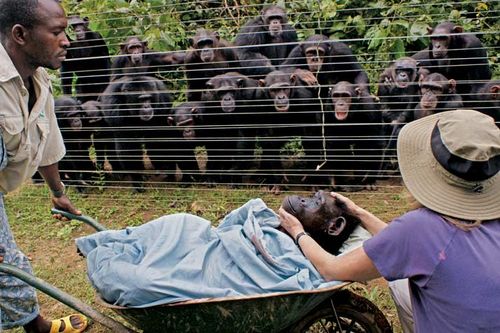
I had a picture of Halloween sausage costumes, but you know what's really spooky? We're all going to die eventually. Now go ahead, kids—take one piece of candy each.
The photo at left was sent to me by alert reader Ben Fowlkes, whose near-constant cruising for chimpanzee snuff movies on the internet is interrupted only by his cruising for chimpanzee snuff porn movies on the internet. National Geographic published this photograph of Dorothy, a female chimpanzee in her late forties who died of congestive heart failure. According to the NGM blog, the other chimps in the Sanga-Young Chimpanzee Rescue Center gathered to watch her burial in eerie silence. “If one knows chimpanzees, then one knows that [they] are not [usually] silent creatures,” said photographer, center volunteer and typographical error Monica Szczupider. Dorothy was a maternal figure for many of the residents of Sanga-Yong, which rehabilitates chimps traumatized by habitat loss or the African bushmeat trade. It would appear that the chimps pictured above are grieving. Next time someone smugly refutes Darwin’s theory of species differentiation through natural selection by pointing out that his grandma wasn’t an orangutan, viewing this picture gives you legal grounds to slap him in the mouth.


